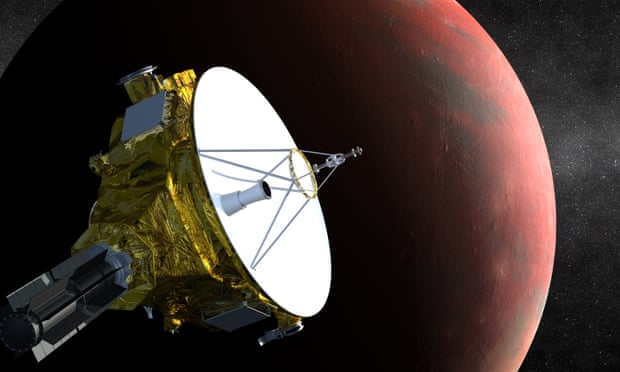Nasa's first close-up images of Pluto to come to Canberra tracking station
Australian scientists are gearing up for a historic moment in space exploration as a tracking station in Canberra becomes responsible for receiving the world’s first close-up images of Pluto on Tuesday evening.
Nine and a half years after it left Earth and having clocked up 5bn kilometres of space travel, Nasa’s New Horizons spacecraft will make its closest encounter with Pluto at exactly 9:49.57pm AEST (12.49.57pm BST or 7:49.57am EST) on Tuesday.
The Canberra deep space communication complex, run by Australia’s national science agency CSIRO, will be the first ground station to receive the images.
The complex is one of three Nasa-JPL deep space network stations, with those in Madrid, Spain, and Goldstone, in California, each separated by roughly 120 degrees longitude and together providing around-the-clock two-way radio contact with the spacecraft.
Lewis Ball, director of CSIRO astronomy and space science, said the mission was “one of the really great explorations of our times”.
It was the first time humans had explored up close the edges of the solar system, he said, and scientists were hoping it would provide important information about the origin and evolution of Earth and other planets.
Ball called the mission an “archaeological space dig”. Reaching Pluto has been “a priority for space science for years”, he said, as it is believed to store the building blocks of our solar system in a “deep freeze for billions of years”.
Although the planet is known to be rich in carbon-bearing molecules as well as water ice, “types of molecules [that] are the raw materials from which life develops ... nobody is expecting to find life on Pluto”.
New Horizons is a small spacecraft, only a few metres long, and does not carry enough fuel to slow down, land or go into orbit around Pluto.
The spacecraft will fly 12,500km above the surface of the dwarf planet over a 24-hour period, collecting detailed measurements and capturing the first surface images.
It is one of the fastest spacecraft ever launched from Earth, travelling at a speed of 14.5km a second or 52,000km an hour.
The complex’s director, Ed Kruzins, said it has a history of nearly 50 years working with Nasa, including during the Apollo 11 moon landing.
On Tuesday evening the station, including 92 Australian scientists and staff members, will be at “level one” – the highest level of alert. The scientists had “rehearsed this a number of times”.
They will receive the data using the station’s 70-metre antenna, the largest in the southern hemisphere.
The data is digitally transmitted, and takes 4.5 hours to reach Earth. It will be transmitted at 1-2 kilobytes a second, much slower than average internet speeds. A one-hour live broadcast of the events on the Nasa website will begin at 9.30pm AEST.
Kruzins said Pluto is a “very strange world” and this mission will collect new information about its atmospheric temperature and pressure.
Data already sent from the craft since it came out of hibernation in December has provided new information about the position of the moons that orbit Pluto, confirmed the presence of methane ice, and revealed the planet’s reddish appearance, with dark spots about 500km long.
The station will receive data for up to an hour, before handing over to Madrid. It will resume receiving data at roughly 5pm on Wednesday.
Nasa's first close-up images of Pluto to come to Canberra tracking station
![Nasa's first close-up images of Pluto to come to Canberra tracking station]() Reviewed by Thailand Life
on
8:40 AM
Rating:
Reviewed by Thailand Life
on
8:40 AM
Rating:



No comments: